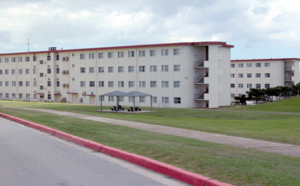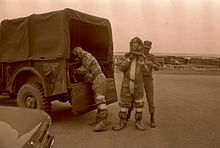
Okinawa Prefecture is a prefecture of Japan. Okinawa Prefecture is the southernmost and westernmost prefecture of Japan, has a population of 1,457,162 and a geographic area of 2,281 km2.

Polychlorinated biphenyls (PCBs) are highly carcinogenic chemical compounds, formerly used in industrial and consumer products, whose production was banned in the United States by the Toxic Substances Control Act in 1979 and internationally by the Stockholm Convention on Persistent Organic Pollutants in 2001. They are organic chlorine compounds with the formula C12H10−xClx; they were once widely used in the manufacture of carbonless copy paper, as heat transfer fluids, and as dielectric and coolant fluids for electrical equipment.

Ginowan is a city located in Okinawa Prefecture, Japan. As of 2012, the city has an estimated population of 94,405, with 40,041 households and a population density of 4,838.8 persons per km2. The total area is 19.51 km2.
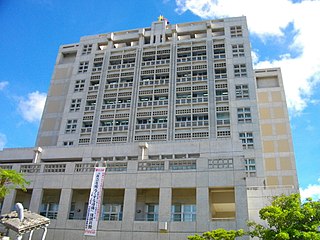
Urasoe is a city located in Okinawa Prefecture, Japan. The neighboring municipalities are Naha to the south, Ginowan to the north, and Nishihara to the east. As of November 2012, the city has an estimated population of 113,718 and a population density of 5,956.9 persons per km2. The total area is 19.09 km2.

United States Forces Japan (USFJ) is a subordinate unified command of the United States Indo-Pacific Command (USINDOPACOM). It was activated at Fuchū Air Station in Tokyo, Japan, on 1 July 1957 to replace the Far East Command. USFJ is commanded by the Commander, US Forces Japan (COMUSJAPAN) who is dual-hatted as commander of the Fifth Air Force. U.S. Forces Japan is currently headquartered at Yokota Air Base in Tokyo.
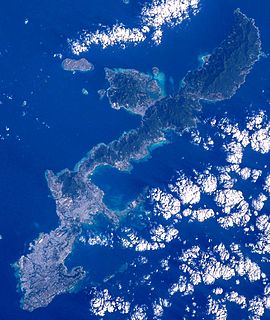
Okinawa Island is the largest of the Okinawa Islands and the Ryukyu (Nansei) Islands of Japan in the Kyushu region. It is the smallest and least populated of the five main islands of Japan. The island is approximately 106 kilometres (66 mi) long, an average 11 kilometres (7 mi) wide, and has an area of 1,206.98 square kilometers (466.02 sq mi). It is roughly 640 kilometres (400 mi) south of the main island of Kyushu and the rest of Japan. It is 500 km (300 mi) north of Taiwan. The total population of Okinawa Island is 1,384,762. The Greater Naha area has roughly 800,000 residents, while the city itself has about 320,000 people. Naha is the seat of Okinawa Prefecture on the southwestern part of Okinawa Island. Okinawa has a humid subtropical climate.

Marine Corps Air Station Futenma or MCAS Futenma is a United States Marine Corps base located in Ginowan, Okinawa, Japan, 5 NM northeast of Naha, on the island of Okinawa. It is home to approximately 3,000 Marines of the 1st Marine Aircraft Wing and other units, and has been a U.S. military airbase since the defeat of the Japanese Imperial Army in the Battle of Okinawa in 1945. Marine Corps pilots and aircrew are assigned to the base for training and providing air support to other land and sea-based Marines in Okinawa and throughout the Asia-Pacific region. MCAS Futenma is part of the Marine Corps Installations Pacific command.

III Marine Expeditionary Force is a formation of the Marine Air-Ground Task Force of the United States Marine Corps. It is forward-deployed and able to rapidly conduct operations across the spectrum from humanitarian assistance and disaster relief (HA/DR) to amphibious assault and high-intensity combat.

Camp Schwab is a United States Marine Corps camp located in northeastern Okinawa Prefecture, Japan, that is currently home to the 4th Marine Regiment and other elements of the 28,000 American servicemen based on the island. The Camp was dedicated in 1959 in honor of Medal of Honor recipient Albert E. Schwab who was killed in action during the Battle of Okinawa.

Marine Corps Base Camp Lejeune is a 246-square-mile (640 km2) United States military training facility in Jacksonville, North Carolina. Its 14 miles (23 km) of beaches make the base a major area for amphibious assault training, and its location between two deep-water ports allows for fast deployments. The main base is supplemented by six satellite facilities: Marine Corps Air Station New River, Camp Geiger, Stone Bay, Courthouse Bay, Camp Johnson, and the Greater Sandy Run Training Area. The Marine Corps port facility is in Beaufort, at the southern tip of Radio Island. It is military property but is occupied only during military port operations. In November 2022, It will also be hosting the Armed Forces Classic.

Camp Foster, formerly known as Camp Zukeran, is a United States Marine Corps camp located in Ginowan City with portions overlapping into Okinawa City, Chatan town and Kitanakagusuku village in the Japanese prefecture of Okinawa Island. It is part of the Marine Corps Base Camp Smedley D. Butler complex.
Combat service support is a topic that is, broadly speaking, a subset of military logistics. However, combat service support is often more limited in depth, as the related groups primarily address factors supporting readiness for combat operations. The United States Department of Defense organizes various agencies providing services such as medical assistance, for example, akin to other nations' militaries.

The 3rd Marine Logistics Group is the Logistics Combat Element (LCE) for III Marine Expeditionary Force currently headquartered on Camp Kinser, Marine Corps Base Smedley D. Butler, Okinawa, Japan. 3rd MLG provides combat service support (CSS) to III MEF units above the organic capability. CSS is the essential capabilities, functions, activities, and tasks necessary to sustain all elements of operating forces in theater at all levels of war. Combat service support includes, but is not limited, to supply, maintenance, transportation, general engineering, health services, and other services required by aviation and ground combat forces to permit those units to accomplish their missions.

The Combat Logistics Regiment 35 (CLR-35) was a logistics unit of the United States Marine Corps that was headquartered at Camp Kinser, Okinawa, Japan. When active, the unit fell under the 3rd Marine Logistics Group and the III Marine Expeditionary Force. The unit was formerly known as 3rd Materiel Readiness Battalion but officially changed its designation on October 20, 2006.
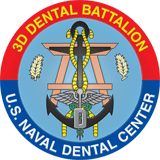
The 3rd Dental Battalion is a unit of the United States Navy that supports United States Marine Corps forces on Okinawa, Japan. The battalion includes nine dental clinics, approximately 77 Dental Officers, 4 Medical Service Corps officers, 181 Dental Technicians, and 26 civilians. The unit is based out of Camp Foster and falls under the command of the 3rd Marine Logistics Group and the III Marine Expeditionary Force.
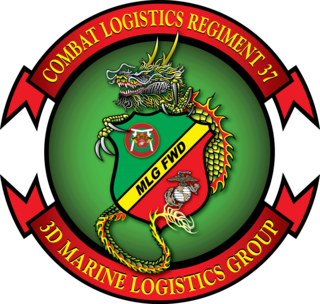
Combat Logistics Regiment 37, 3rd MLG is a logistics regiment of the United States Marine Corps. It is part of the 3rd Marine Logistics Group and III Marine Expeditionary Force. The unit is based out of the Marine Corps Base Camp Kinser, Okinawa, Japan.

The 3rd Supply Battalion is a battalion of the United States Marine Corps that specializes in distributing and warehousing military goods and equipment. They are headquartered at Camp Kinser, with their most remote company of Marines, Ammunition Company, located 37 miles north of Camp Kinser aboard Camp Schwab near the town of Henoko, Okinawa, Japan and fall under the command of the 3rd Marine Logistics Group.

The 3rd Maintenance Battalion is a battalion of the United States Marine Corps that provides intermediate-level maintenance for the III Marine Expeditionary Force's tactical ordnance, engineer, motor transport, communications electronics and general support ground equipment. The unit falls under the command of 3rd Sustainment Group (Experimental) and the 3rd Marine Logistics Group, and is based at Camp Kinser, Okinawa, Japan, with the exception of Engineer and Regional Maintenance Operations Companies, which are located at nearby Camp Foster and Camp Hansen, respectively.
Persistent, bioaccumulative and toxic substances (PBTs) are a class of compounds that have high resistance to degradation from abiotic and biotic factors, high mobility in the environment and high toxicity. Because of these factors PBTs have been observed to have a high order of bioaccumulation and biomagnification, very long retention times in various media, and widespread distribution across the globe. Most PBTs in the environment are either created through industry or are unintentional byproducts.

United States nuclear weapons were stored secretly at bases throughout Japan following World War II. Secret agreements between the two governments allowed nuclear weapons to remain in Japan until 1972, to move through Japanese territory, and for the return of the weapons in time of emergency.
